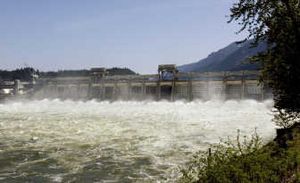BPA paid $644 million for fish-wildlife in 2012
RIVERS -- In Fiscal Year 2012, the Bonneville Power Administration reported $644.1 million in total costs for its federally mandated actions to mitigate the impacts Columbia River Basin hydroelectric development has had on fish and wildlife.
The costs are listed an annual report released last week by the Northwest Power and Conservation Council to the governors of Idaho, Montana, Oregon and Washington.
The Northwest Power passed by Congress in 1980 requires BPA, which markets power generated at federal dams in the region, to fund the NPCC programs undertaken by state and federal agencies and some tribes.
Bonneville estimates the grand total expended since 1978, when the costs began, through 2012, is about $13 billion, not including $2.27 billion in capital investments for fish hatcheries and fish passage facilities at dams.
Read on for a summary of the 2012 costs, compiled by the Columbia Basin Bulletin:
BPA costs for 2012 include:
--$248.9 million in direct (expense) costs;
-- $73.0 million in direct costs and reimbursements to the U.S. Treasury for expenditures by the Corps of Engineers, Bureau of Reclamation, and U.S. Fish and Wildlife Service for investments in fish passage and fish production, including direct funding of operations and maintenance expenses of federal fish hatcheries;
-- $131.5 million in fixed costs (interest, amortization, and depreciation) of capital investments for facilities such as hatcheries, fish passage facilities at dams, and some land purchases for fish and wildlife habitat;
-- $152.2 million in forgone hydropower sales revenue that results from dam operations that benefit fish but reduce hydropower generation, and
-- $38.5 million in power purchases during periods when dam operations to protect migrating fish reduce hydropower generation, such as by spilling water over dams in the spring or storing it behind dams in winter months in anticipation of required spring spills.
“The $644.1 million total does not include annual capital investments in 2012 totaling $57.5 million for Program related projects, and $114.5 million for associated federal projects, including capital investments at dams operated by the Corps of Engineers and Bureau of Reclamation. These investments are funded by congressional appropriations and repaid by Bonneville,” the report says.
Bonneville estimates that the 2012 costs bring the grand total, from 1978 when the costs began, through 2012, to about $13 billion (the total does not include $2.27 billion in capital investments, discussed above, such as the construction costs of facilities like fish hatcheries and fish-passage facilities at the dams, or $1.79 billion in credits from the federal government that effectively reduce the total annual obligation by Bonneville).

